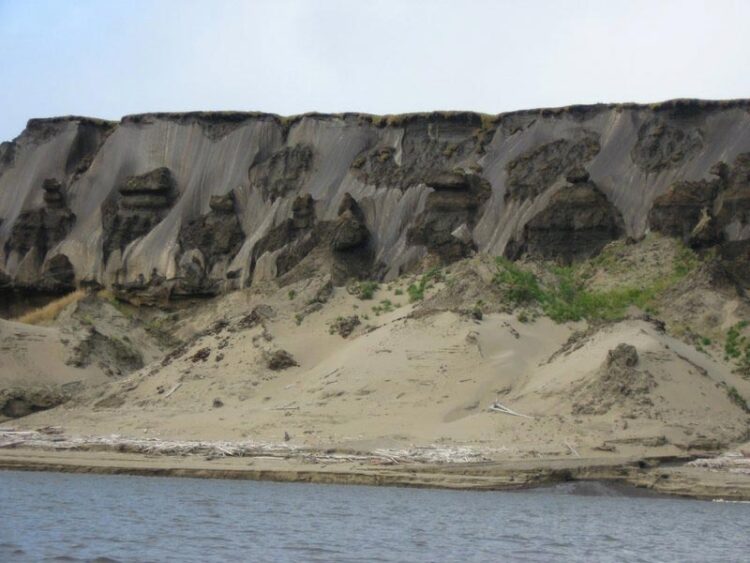Thawing permafrost can accelerate global warming

Outcrop of Yedoma sediments with the thick ice masses underlain by river sediments exposed on an arm of the Lena River in the river delta. Copyright: Janet Rethemeyer
Insufficiently considered carbon stocks in very old sediments are released as greenhouse gases / publication in ‘Frontiers in Earth Science’.
Thawing permafrost in the Arctic could be emitting greenhouse gases from previously unaccounted-for carbon stocks, fuelling global warming. That is the result of a study conducted by a team of geologists led by Professor Dr Janet Rethemeyer at the University of Cologne’s Institute of Geology and Mineralogy, together with colleagues from the University of Hamburg and the Helmholtz Centre Potsdam – GFZ German Research Centre for Geosciences. In the Siberian Arctic, the research team determined the origin of carbon dioxide released from permafrost that is thousands of years old. This research endeavour is part of the German-Russian research endeavour ‘Kopf – Kohlenstoff im Permafrost’, funded by the German Federal Ministry of Education and Research (BMBF). The paper ‘Sources of CO2 Produced in Freshly Thawed Pleistocene-Age Yedoma Permafrost’ has now appeared in Frontiers in Earth Science.
Global climate change is causing temperatures to rise sharply, especially in the Arctic. Among other things, higher temperatures are causing more and more permafrost soils, which have been frozen for thousands of years, to thaw. Particularly affected is so-called ‘yedoma’ permafrost, which is widespread in areas that were not covered by ice sheets during the last ice age. Yedoma contains up to 80 per cent ice and is therefore also called ice complex. The ground ice can thaw very abruptly, causing the bedrock to collapse and erode. Such processes, known as thermokarst, make carbon previously stored in the frozen ground accessible to microorganisms, which break it down and release it as carbon dioxide and methane. The greenhouse gas release amplifies global warming, which is known as permafrost-carbon feedback.
So far, there are still many uncertainties about the amount of future greenhouse gas release. Among other things, it is not clear how well the ancient carbon that has been frozen in permafrost for thousands of years can be degraded. To find out, the research team took carbon dioxide samples at the Siberian investigation site on the Lena River using specially designed equipment in which carbon dioxide can be stored airtight and transported manner for long periods of time. This is necessary due to the long transport to Germany. Back in Cologne, the researchers then determined the age of the carbon dioxide using the radiocarbon method. In addition, they analysed the non-radioactive carbon isotopes. Both parameters were then used to calculate how much old and young as well as organic and inorganic carbon had been decomposed in the thawing permafrost.
A large proportion of the carbon – up to 80 per cent – comes from ancient organic matter that was freeze-locked into the sediments more than 30,000 years ago. This means that vegetation remains that died thousands of years ago have been very well ‘preserved’ in the frozen sediment, making them an attractive food source for microorganisms in the thawing permafrost.
In addition, the team found out for the first time that up to 18 per cent of carbon dioxide comes from inorganic sources. ‘We did not expect that this previously unnoticed carbon source would account for such a high proportion of the total amount of greenhouse gases released,’ said first author of the study Jan Melchert from the University of Cologne. For more precise climate predictions, it would be necessary to take this source into account. Future research will have to clarify where exactly the inorganic carbon in the yedoma comes from and through which processes it is released.
Media Contact:
Professor Dr Janet Rethemeyer
Institute of Geology and Mineralogy, University of Cologne
+49 221 470 7317
janet.rethemeyer@uni-koeln.de
Press and Communications Team:
Eva Schissler
+49 221 470 4030
e.schissler@verw.uni-koeln.de
Publication:
https://www.frontiersin.org/articles/10.3389/feart.2021.737237/full
Media Contact
All latest news from the category: Earth Sciences
Earth Sciences (also referred to as Geosciences), which deals with basic issues surrounding our planet, plays a vital role in the area of energy and raw materials supply.
Earth Sciences comprises subjects such as geology, geography, geological informatics, paleontology, mineralogy, petrography, crystallography, geophysics, geodesy, glaciology, cartography, photogrammetry, meteorology and seismology, early-warning systems, earthquake research and polar research.
Newest articles

Innovative 3D printed scaffolds offer new hope for bone healing
Researchers at the Institute for Bioengineering of Catalonia have developed novel 3D printed PLA-CaP scaffolds that promote blood vessel formation, ensuring better healing and regeneration of bone tissue. Bone is…

The surprising role of gut infection in Alzheimer’s disease
ASU- and Banner Alzheimer’s Institute-led study implicates link between a common virus and the disease, which travels from the gut to the brain and may be a target for antiviral…

Molecular gardening: New enzymes discovered for protein modification pruning
How deubiquitinases USP53 and USP54 cleave long polyubiquitin chains and how the former is linked to liver disease in children. Deubiquitinases (DUBs) are enzymes used by cells to trim protein…



